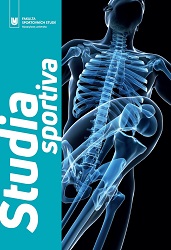Síla pletence ramenního a flexorů prstů v predikci lezeckého výkonu žen
Shoulder girdle strength and finger flexor strength in prediction of performance in female rock climbers
Author(s): Jan Kodejška, Jiří BalášSubject(s): Sports Studies
Published by: Masarykova univerzita nakladatelství
Keywords: rock climbing; shoulder girdle strength; finger flexor strength; specific tests
Summary/Abstract: Aim. The aim of this study was to evaluate relationships between the rock climbing performance and the strength of finger flexors and shoulder girdle muscles in female rock climbers. Methods. Twenty one female climbers completed six specific climbing tests focused on finger flexor and shoulder girdle muscles strength: finger hang, maximal strength in open crimp, bent arm hang on one arm, bent arm hang on two arms, diagonal reach, power slap. Relationship to the climbing performance RP (Red point) was assessed by a coefficient of determination. Linear regression analysis was used to determine the relative contribution of tests’ strength in the model. Results. Diagonal reach (R2 = 0.76), power slap (0.74) and finger hang (0.72) explained the greatest part of climber’s performance variability. The test diagonal reach showed high consistency (intra-class correlation coefficient, left 0.98; right 0.97). The greatest relative strength in the regression linear model had power slap. Conclusion. This study introduced a new specific climbing test diagonal reach. It was found that this test has a high reliability and criterion validity and is to assess static shoulder girdle strength in rock climbers. It was shown that shoulder girdle strength is an important factor to achieve high performance in female rock climbers.
Journal: Studia sportiva
- Issue Year: 10/2016
- Issue No: 2
- Page Range: 46-54
- Page Count: 8
- Language: Czech

